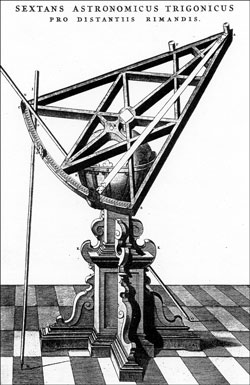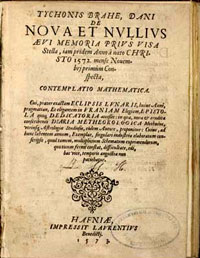The astronomy of Tycho Brahe
On the 11th of November 1572 Tycho observed a new star that shined so brightly that it could also be seen during the day. He measured that it was farther away than the Moon and in the same year wrote a book about Stella Nova, which he called "the greatest miracle of nature since the creation of the world".

Tycho Brahe's large sextant for the measuring of angles between two stars.
In the times of Tycho Brahe it was thought that space beyond the Moon was unchanging so the new star had to be a miracle. The book about Stella Nova made Tycho famous in all of Europe. When he later discovered that comets were more distant than the Moon, he stopped seeing these phenomena as miracles.
After Stella Nova he was determined to be an astronomer and not to follow the usual career of a nobleman with the administrative and social obligations.
He wanted to create a new foundation for astronomy and knew that it would require many measurements, night after night, year after year. He especially needed to observe Mars because he realized that by doing so he could determine whether the planets revolved around the Sun as Copernicus had suggested in his book from 1543. In that system Mars would be at a different distance than in the geocentric system, surviving from antiquity, where the planets and the Sun revolve around the Earth.

Stella Nova. This book contains the "mathematical consideration" of Tycho Brahe about the new star, which was first observed in November 1572.
The decision between the two systems could be made if he took very precise measurements. He measured the position of a planet by measuring the angle from the planet to nearby stars with known positions. He also needed a "reference system" of stars measured in relationship to each other and to the Sun. His reference system of a few hundred stars actually required many more observations than the planets in order to be good enough.
No one had done this before with such accuracy. The enormous investments and operating expenses were paid for by the Danish king.
Written by astronomer dr. scient. Erik Høg, emeritus at the Niels Bohr Institute.
